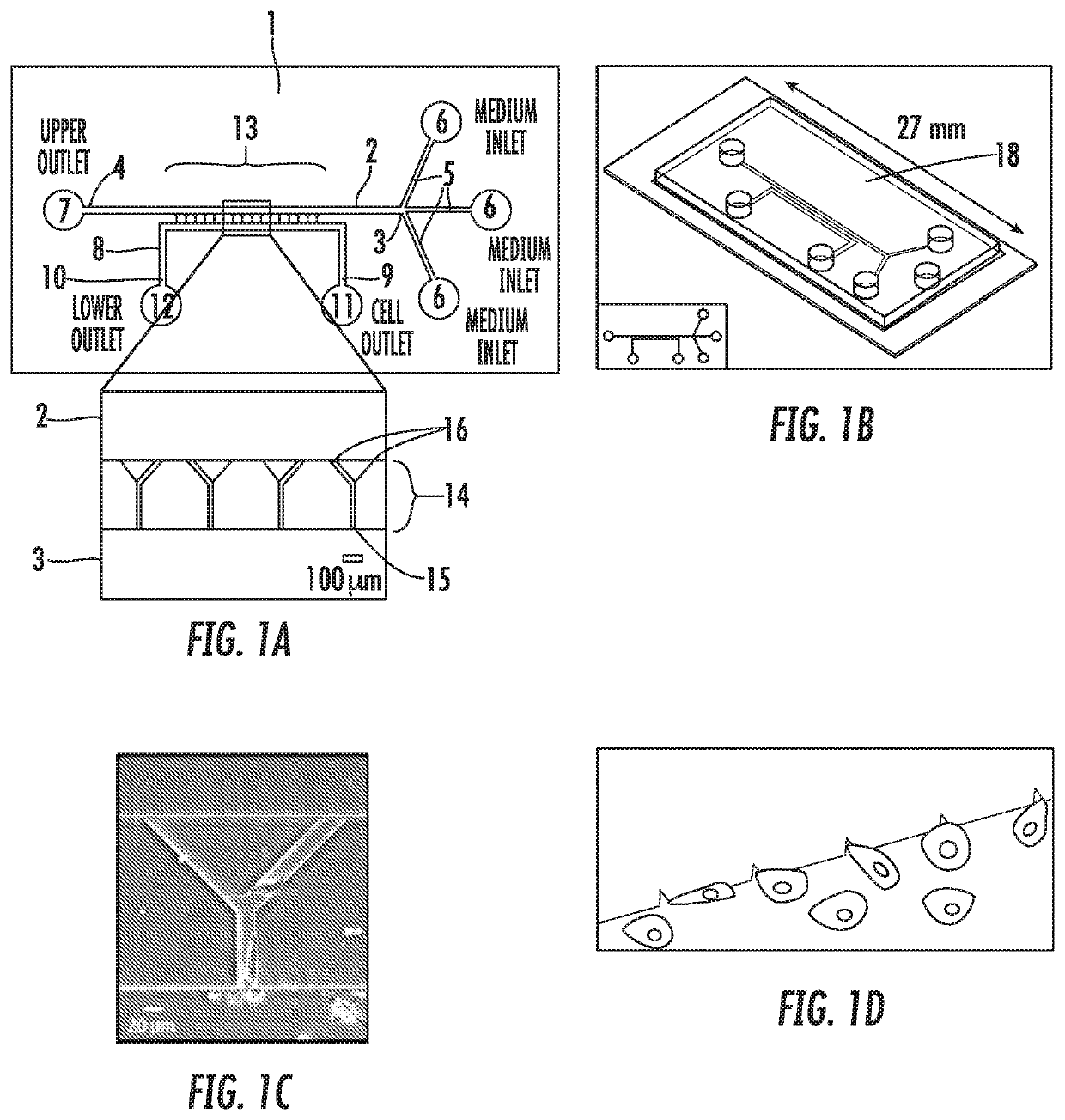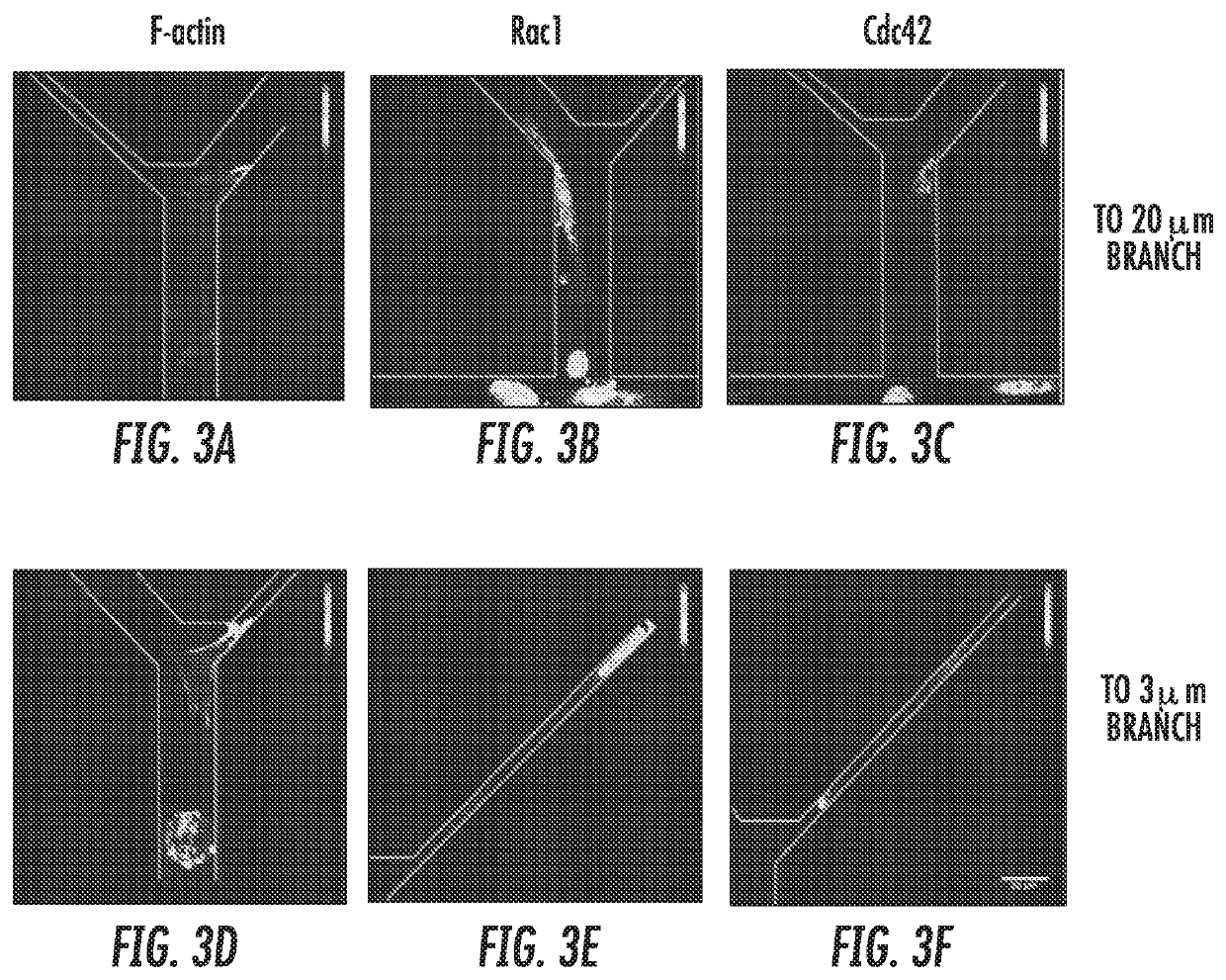Use of an integrated microfluidic chip for analysis of cell motility and prediction and prognosis of patient survival
- Summary
- Abstract
- Description
- Claims
- Application Information
AI Technical Summary
Benefits of technology
Problems solved by technology
Method used
Image
Examples
example 1
[0088]Bifurcating Channels Allow Identification of Migratory Cells: Cell tracking of all MDA-MB-231 cells within the channels revealed two distinct subpopulations: migratory and non-migratory cells (FIGS. 2A,B). 22±3% of human metastatic MDA-MB-231 breast cancer cells were migratory. Interestingly, this subpopulation correlates with the % of MDA-MB-231 (28%) bearing the CD44+ / CD24− molecular signatures that is used to define breast cancer stem cells. Migratory cells, defined as those cells reaching the branch channels, migrated more than twice as fast as non-migratory cells (FIG. 2C). Migratory cells were also significantly more directional. The chemotactic index of migratory cells increased to 0.91 in comparison to a chemotactic index of 0.37 for nonmigratory cells.
[0089]Analysis of cell shape indicated that migratory cells were aligned with and elongated along the channel wall. The fit elliptical angle of a cell perfectly aligned along the wall was 90°. Although both migratory and...
example 2
[0090]Contact Guidance Overcomes Steric Hindrance for Migratory Cells: Of those cells that were migratory, the vast majority moved preferentially along one wall of the feeder channels and remaining polarized, with a significantly lower number of changes in direction compared to non-migratory cells. Representative cell tracks illustrating this trend are shown in FIG. 4A. Interestingly, migration direction at the bifurcation was not dependent on the width of the resultant branch, even though entering the 3 μm-wide branch required significant deformation of the cell body. Instead, cells continued to be polarized and moved readily into the “branch” channel, regardless of the branch channel width (FIG. 4B). Thus, contact guidance dominated steric hindrance at these channel widths for migratory cells and was likely the driver of directed migration for this subpopulation.
example 3
[0091]PI3K Inhibition Promotes Spontaneous Migration of MDA-MB-231 Cells: There is evidence that PI3K signaling is required to stabilize nascent protrusions. New protrusions away from the wall along which a cell is migrating would discourage contact guidance. Therefore, it was investigated whether inhibiting PI3K could promote contact guidance in 200 μm-long microchannels.
[0092]Inhibition of PI3K signaling using the PI3K inhibitor LY294002 increased the migratory cell population in 200 μm-long microchannels from 25% to 65% and the ratio of contact guided cells from 66% to 93% (FIG. 4A,B). PI3K inhibition did not impact overall cell speed, as control and LY294002-treated cells moved at the same average speed (FIG. 5C). However, cells in which PI3K signaling was inhibited moved with greater directionality, as indicated by the higher chemotactic index for these cells vs. control cells (FIG. 5D). This result is consistent with the expected inhibition of nascent protrusions upon LY294002...
PUM
 Login to View More
Login to View More Abstract
Description
Claims
Application Information
 Login to View More
Login to View More - R&D
- Intellectual Property
- Life Sciences
- Materials
- Tech Scout
- Unparalleled Data Quality
- Higher Quality Content
- 60% Fewer Hallucinations
Browse by: Latest US Patents, China's latest patents, Technical Efficacy Thesaurus, Application Domain, Technology Topic, Popular Technical Reports.
© 2025 PatSnap. All rights reserved.Legal|Privacy policy|Modern Slavery Act Transparency Statement|Sitemap|About US| Contact US: help@patsnap.com



